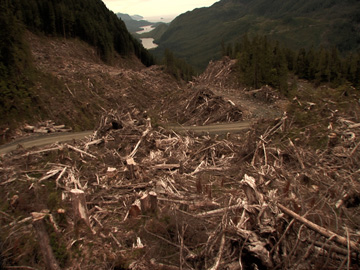 This year the winter solstice brings ill tidings to us northern folk. Canada was seen by the world as one of worst adversaries of environmental change.
This year the winter solstice brings ill tidings to us northern folk. Canada was seen by the world as one of worst adversaries of environmental change.At the Bali Climate Change Summit nations met to work towards a new global treaty, which would include setting carbon emissions for rich countries. Canada teamed up with the United States to block the consensus reached by all the other countries present at the global summit. Then a group of countries, all of which had signed the Kyoto treaty, tried to move forward without the USA but they were blocked by Canada.
In just a few days 110,000 Canadians joined a petition to let our political leaders know that they were not acting upon the wishes of the general public at the Bali summit. Thousands phoned, faxed, wrote, and e-mailed members of the government. At the 11th hour Canada finally backed down. All countries present at the summit booed the USA. At the last minute the USA finally reversed their negative stance.
600,000 signatures from 192 countries were presented to politicians at the summit demanding they recognize that the citizens of this planet want to work towards global climate solutions. However, as a result of Canada’s negotiations, massive compromises were established at the end of the summit. Regulations for emissions and other environmental standards were lowered significantly to meet the demands of Canada and the USA.
The European nations talk big but they also, are not meeting the regulations to reduce emissions set for the world. The Bali summit has merely established that countries in attendance have agreed to the framework for a Climate Change Treaty, which will be formulated and voted upon at a later date.
At home the Harper government claimed victory at Bali and continues to talk enviro-jargon after putting up a massive fight that has compromised efforts to reduce emissions and environmental damage to the atmosphere of this planet. Meanwhile the vast majority of Canadians want to reduce the environmental footprint we are making upon this planet.
Then again, checkout the malls. How many SUVs, massive trucks, single occupancy vehicles are in the parking lots? Consumerism is the number one threat to the environment. On an individual basis we all have an obligation to reduce the amount we consume. Most products contain plastic, deprived from oil and a great deal of oil was burned to deliver most items to the consumer. How long will the individual actually use the item?
Canada chooses to extract the mostly costly source of oil on Earth, while our government blocks international efforts to reduce green house gases. Many scientists agree that this economic oil boom will become our worst nightmare by destroying the atmosphere that provides us with life.
The largest deposit of tar sands on Earth is located in the Athabasca oil sands of northeast Alberta around Fort McMurray. Tar-sand oil extraction projects do the most damage to the environment of any energy source on the planet. First massive open-pit mining is used to remove the tar, which is fused with sand. As part of the extraction process vast amounts of clean water are used in a process called Steam Assisted Gravity Drainage. The water is then discarded as polluted muck. Today in Alberta natural gas, primarily from northern British Columbia, is piped in and burned to generate electricity used to separate the oil from the sand. Plans are underway to build nuclear power plants to produce the electricity to meet the demand.
More than 80 kg of greenhouse gases are released into the atmosphere for every barrel of synthetic oil produced in Alberta, each refined barrel of oil weighs 130 kg. Gasoline refined from tar sand extraction is estimated to result in five times more carbon dioxide than conventional "sweet crude" oil production. The Boreal Forest Ecosystem, recognized as a vital part of Canada’s oxygen production and weather stabilization, is being destroyed by massive excavators scraping the topsoil away to dig down into the tar sand.
You can make a difference by joining the global movement which helps to bring the public’s message to the attention of international decision makers, for more information about public input into climate change check out: www.avaaz.org






